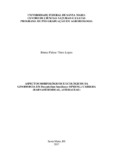| dc.creator | Lopes, Bruna Palese Thies | |
| dc.date.accessioned | 2018-05-24T15:30:05Z | |
| dc.date.available | 2018-05-24T15:30:05Z | |
| dc.date.issued | 2017 | |
| dc.identifier.uri | http://repositorio.ufsm.br/handle/1/13247 | |
| dc.description.abstract | Dasyphyllum brasiliense has two sexual systems: monoecious and gynodioecious, being the studied population characterized as gynodioecy, constituted by complete and pistilated individuals. The evolution of this system depends on the influence of the medium on the morphology and biology of the different floral types. Studies that unite these areas are extremely important in understanding the evolution of gynodioecy. In this way, the objective of this work was to compare the floral morphology, the development of stamens / staminodes and ecological aspects in a population of the species. The different individuals have clear differences in flower size and morphology. Floral pieces are larger in whole individuals except stigma, which has larger lobes, in addition to containing more trichomes and a wider degree of aperture. The anthers of complete flowers have common development for the family and the abortion in the other morph occurs during the development of the parietal layers, what establishes these individuals like pistillates. The complete individuals have a greater diversity of floral visitors, but the species that participates most in pollination in both is Apis melifera. Through these data and phenology, which shows a higher percentage of phenophases in complete individuals in the population, it can be thought that these have a greater advantage over the others, but the pistillates individuals occur in greater numbers in the population, a fact that must have relation with the high predation of the seeds, probably due to attractiveness such as greater floral size and presence of pollen grains as food resources. This predation is part of the evolutionary process, allowing the population control, in order to keep the individuals pistillates. Thus, the theory of resource allocation can be established in the evolutionary process of the species. | eng |
| dc.description.sponsorship | Coordenação de Aperfeiçoamento de Pessoal de Nível Superior - CAPES | por |
| dc.language | por | por |
| dc.publisher | Universidade Federal de Santa Maria | por |
| dc.rights | Attribution-NonCommercial-NoDerivatives 4.0 International | * |
| dc.rights.uri | http://creativecommons.org/licenses/by-nc-nd/4.0/ | * |
| dc.subject | Estigma | por |
| dc.subject | Estilete | por |
| dc.subject | Evolução | por |
| dc.subject | Grão de pólen | por |
| dc.subject | Predação | por |
| dc.subject | Stigma | eng |
| dc.subject | Stylus | eng |
| dc.subject | Evolution | eng |
| dc.subject | Pollen grain | eng |
| dc.subject | Predation | eng |
| dc.title | Aspectos morfológicos e ecológicos da ginodioicia em Dasyphyllum brasiliense (spreng.) Cabrera (Barnadesioideae, Asteraceae) | por |
| dc.title.alternative | Morphological and ecological aspects of gynodioecy in Dasyphyllum brasiliense (Spreng.) Cabrera (Barnadesioideae, Asteraceae) | eng |
| dc.type | Dissertação | por |
| dc.description.resumo | Dasyphyllum brasiliense possui dois sistemas sexuais: monoico e ginodioico, sendo a população estudada caracterizada como ginodioica, constituída por indivíduos completos e pistilados. A evolução desse sistema depende da influencia do meio sobre a morfologia e biologia dos diferentes tipos florais. Estudos que unam estas áreas são extremamente importantes no entendimento da evolução da ginodioicia. Desta forma, este trabalho teve por objetivo comparar a morfologia floral, o desenvolvimento dos estames/estaminódios e aspectos ecológicos em uma população da espécie. Os diferentes indivíduos possuem claras diferenças de tamanho e morfologia das flores. As peças florais são maiores nos indivíduos completos, exceto ao estigma, que possui lobos maiores, além de conter mais tricomas e um grau de abertura mais amplo. As anteras de flores perfeitas possuem desenvolvimento comum para a família e o abortamento no outro morfo ocorre durante o desenvolvimento das camadas parietais, o que estabelece estes indivíduos como pistilados. Os indivíduos completos tem maior diversidade de visitantes florais, porém a espécie que mais participa da polinização em ambos é Apis melifera. Através destes dados e da fenologia, que mostra maior percentagem de fenofases em indivíduos completos na população, pode ser pensado que estes têm maior vantagem sobre os demais, porém os indivíduos pistilados ocorrem em maior número na população, fato que deve ter relação com a alta predação das sementes, provavelmente devido a atrativos como maior tamanho floral e presença de grãos de pólen como recurso alimentar. Esta predação faz parte do processo evolutivo, permitindo o controle populacional, de forma a manter os indivíduos pistilados. Sendo assim a teoria da alocação de recursos pode se estabelecer no processo evolutivo da espécie. | por |
| dc.contributor.advisor1 | Oliveira, João Marcelo Santos de | |
| dc.contributor.advisor1Lattes | http://lattes.cnpq.br/3533863401498975 | por |
| dc.contributor.referee1 | Simão, Daniela Guimarães | |
| dc.contributor.referee1Lattes | http://lattes.cnpq.br/8597424381029448 | por |
| dc.contributor.referee2 | Moço, Maria Cecília | |
| dc.contributor.referee2Lattes | http://lattes.cnpq.br/8433358795808593 | por |
| dc.creator.Lattes | http://lattes.cnpq.br/0998352681603367 | por |
| dc.publisher.country | Brasil | por |
| dc.publisher.department | Agronomia | por |
| dc.publisher.initials | UFSM | por |
| dc.publisher.program | Programa de Pós-Graduação em Agrobiologia | por |
| dc.subject.cnpq | CNPQ::CIENCIAS AGRARIAS::AGRONOMIA | por |
| dc.publisher.unidade | Centro de Ciências Naturais e Exatas | por |



